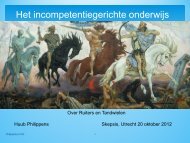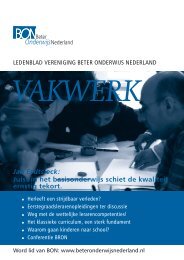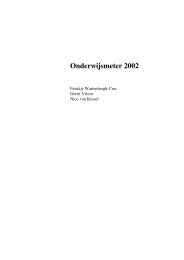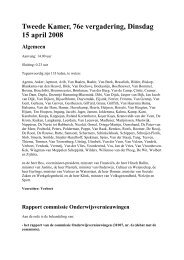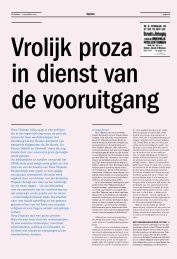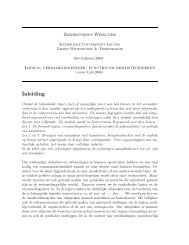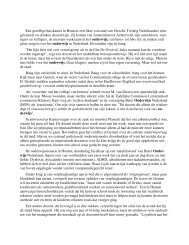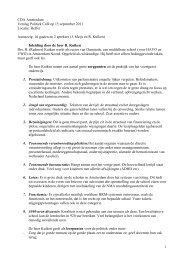Leraar worden:'under construction'? - Open Universiteit Nederland
Leraar worden:'under construction'? - Open Universiteit Nederland
Leraar worden:'under construction'? - Open Universiteit Nederland
You also want an ePaper? Increase the reach of your titles
YUMPU automatically turns print PDFs into web optimized ePapers that Google loves.
86<br />
Ultimately, then, Von Glasersfeld’s position is a kind of co-ordinated solipsism which gives rise to relativistic<br />
interpretations. Even though it seems the opposite of cognitivist structuralism, the two interpretations<br />
sometimes go very well together: namely, when ‘’facts’’ are considered a totally different<br />
category from ‘’values’’. This opens the possibility that people (tendentially and ideally) agree on facts,<br />
but value them differently without a possibility of co-ordination: the ultimate argument is ‘’this is how<br />
I see it’’.<br />
Somewhere between these two extremes is ‘’social constructivism’’. As its name suggests, the principle<br />
here is that knowledge is a social construction. This is true on two levels: of the developing person<br />
(ontogenesis) and of the developing social group or society (sociogenesis). It is not the individual as<br />
in radical constructivism, but the social group which decides on what is to be considered a valid interpretation<br />
of the world. In this case, there is no boundary between ‘’facts’’ and ‘’values’’: interpretations<br />
are always value-laden. Also, as in radical constructivism, there are virtually no limits on what can be a<br />
valid interpretation, as the principle is that we cannot know the world as it is. Each culture thus can<br />
construct its own world view. In ontogenesis, this means that learning does not occur in direct relation<br />
with reality (as Piaget supposes) but in social situations; thus, learning is close to socialisation,<br />
except that learners still have to build their own interpretative schemas.<br />
Cultural-historical constructivism, finally, rejects the relativism inherent in radical and social constructivism.<br />
In sociogenesis, cultural instruments or artefacts, among which is conceptual knowledge, are<br />
produced and improved in joint activity (which is directed at satisfying real needs) in the real world,<br />
with the help of previously developed and culturally transmitted artefacts. There is no immediate or<br />
objective knowledge of the world, nor is there a formal logic hardwired in human brains (as Piaget<br />
supposes), which would guarantee the adequacy of knowledge. On the other hand, knowledge is not<br />
constructed arbitrarily: our insights are founded in the real actions of people with the help of cultural<br />
instruments in which the experiences of earlier generations have been materialised, and can thus be<br />
given on. Our experiences are always already structured by the existing instruments, so direct access<br />
to reality is not possible, but reality poses limits on what we can experience and on the interpretations<br />
we can construct: it ‘’resists’’ some interpretations. In ontogenesis, the developing child does not<br />
learn from direct experience in the world; its experiences are always already mediated by other people<br />
and by cultural artefacts (including other people’s construction of the world). The social environments<br />
makes these mediating artefacts available, both accidentally and in a structured way in schools<br />
(here, the main type of artefact is conceptual knowledge). It is learning to use such mediating devices<br />
which drives individual development - not the other way round as Piaget supposes. In this sense, learning<br />
is always a social process: other people are always present, if not bodily, then represented by<br />
their artefacts: reading a book in solitude is an eminently social process.<br />
Learning, however, in this view is not purely adaptive socialisation to an already existing social environment.<br />
To be able to really use a cultural instrument, the learners have to adapt it to their own possibilities<br />
and preferences, and the other way round: the instrument has to become a part of the<br />
person itself. Thus, for instance, you can still write even if you have no writing instrument available;<br />
and our thinking is, in early development, totally transformed by learning to use language as a thinking<br />
instrument. (Language does not just communicate our ideas to others; our ideas are structured<br />
by the processes of language themselves.) Learning, then, is not something purely cognitive; it is<br />
based in (affect driven) motivation to learn and has affective consequences. This way of thinking<br />
about the relation between development and learning is typical for the ‘’sociocultural’’ school or cultural<br />
activity theory, which is based in the work of Vygotsky, a contemporary of Piaget.’<br />
Hirumi (2002) geeft handzame overzichten van uitgangspunten en praktische consequenties van het<br />
cognitief-constructivisme en het sociaal-constructivisme (zie ook Bereiter, 2002; Shayer & Adey, 2002;<br />
Duffy & Jonassen, 1992; Jonassen et al., 1999; Jonassen & Land, 2000; het overzicht van Jörg et al.,<br />
2001; de interessante schets die Donmoyer, 2001, geeft van de ontwikkelingen in de laatste veertig<br />
jaar van ‘research on teaching’ en ‘educationalal research’; Bernstein, 1990, vooral hoofdstuk 2 ‘Social<br />
class and pedagogic practice’).





